Day 2: Macerata
Well now I know you are wondering why I haven't yet included a historical perspective to this account. Well, don't fear as I have done my homework, and here you can read a short (relatively) history of the Italian state. The area of Macerata is part of a larger area known as the Marches. Today, it is comprised of 4 regions shown below.
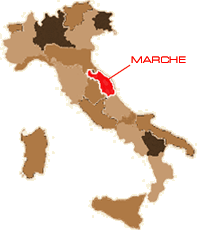
Map of Italy highlighting the Marches.
|
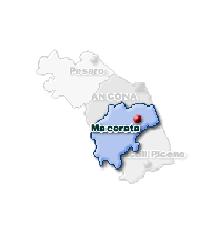
The Marches showing the 4 regions and highlighting Macerata.
|
Before the era of the Romans, the Marches were inhabited by scattered tribes, chief among them the Piceni of the eastern seaboard, and the Umbri of the mountains. Southern Italy was ruled by the Etruscans, and in 509 BC the last Etruscan King, Targuinius Superbus, was defeated by the Romans. Italy was now part of the Roman Empire under the rule of Caesar Augustus and the Marches were divided into two regions: the northern Roman Umbria and the southern Picenum. Almost 1000 years later, the Roman Empire was weakened by a split between the East and the West Empires. This weakness was exploited by attacks into Northern Italy by the Goths and the Vandals. Italy was later conquered by the barbarian warrior Odoacer, who became the first ever King of Italy. But his rule was short lived as he was surplanted 10 years later by Theodoric, King of the Ostrogoths. After the death of King Theodoric, Eastern Roman Emperor Justinian of Constantinople tried to restore imperial power to Italy. With the help of his generals Belisarius and Narses, the Gothic King Toila was toppled in 552 AD. The deciding battle was fought in the Marches in a place named Furlo Gorge. Northern Italy, thus weakened by these attacked became easy prey for an invasion of the Lombards in in 568 AD. The Lombards ruled much of Italy in a time of relative peace for the next 200 years.
Eventhough the Lombards converted to Christianity in the 700's, they were seen as unwelcome guests by the later Popes of this time. In 754, Pope Stephen II called for foreign aid to oust the Lombards from Italy. Thus, a Frankish army lead by Pepin the Short invaded Italy and attempted to remove the Lombards. But it wasn't until the time of Pepin's son, Charlemagne, that this feat was accomplished. As a reward, Pope Leo III crowned Charlemagne the first Holy Roman Emperor, a title that was at first only considered an honary, but would later prove to be the cause of over 1000 years of strife and wars between rival claims of successive Popes and Emperors. Charlemagne's empire grew and flourished under his rule, but crumbled upon his death in 814. Italy was again thrust into a state of anarchy until the Saxon King Otto I laid claim to the title of Emperor. At this time many conflicts grew between Emperor and Pope over who should rule the lands. Consequently, many of the Italian states including the Marches became essentially independent. Many city states grew up at this time, and they held a constant power struggle between one another for many years to come. It wasn't until the time of the Germanic Emperor Frederick Barbarossa I that partial unity was once again restored to Italy. Barbarossa defied the rule of the Pope in Rome, and set up his own Anti-Pope outside of Rome. A united Italy was almost a reality under the rule of Barbarossa's descendent Emperor Frederick II, but following his death in 1250, Italy was once again thrown into choas.
The Holy Roman Empire was divided into 2 factions as once again the Papal and Imperial powers struggled for dominance. The supporters of the Pope were called the Guelphs and included the rising wealthy merchant class. The imperialists were known as the Ghibellines and included the old aristocrats who feared Papal rule. All of Italy was again thrust into combat. The decisive stoke was cast in 1350 when Pope Urban IV asked Charles of Anjou for help against the Ghibellines. With the help of the French the Guelphs were victorious and French power was forever thereafter replacing Germanic influence in the Holy Roman Empire. During the conflict much of Italy again returned to independent rule and wasn't subjected to Papal rule until 1421 when the Papacy was restored in Rome under Pope Martin V.
The 15th century Renaissance period was a time of relative peace and prosperity for much of Italy. This was due in large fact to the Italian League, a defensive treaty between the major Italian powers. During this time much art, culture, and learning was garnered, and the Italian states flourished. But eventually, the individual interests of the leading states lead to quarrels and brought about the end of peace. When the Milanese asked the King Charles VIII of France to settle an agruement with Naples, the French invaded and the Italian League disbanded. And even though the French left Italy 2 years later, this opened the way for another invader, the Spanish. In the years that followed, the French and Spanish Kingdoms fought for control over Italy, and in 1559 the Treaty of Cateau-Cannbresis saw the beginning of over 150 years of Spanish rule in Italy.
The French Revolution of 1789 was felt heavily in Italy. In 1796, Napoleon invaded Italy and set up the former Papal states as Republics. He later created the Kingdom of Italy, which dissolved as soon as Napoleon was overthrown at the hands of the English and Dutch. But Napoleon's Kingdom rekindled a sense of nationalism and independence in the Italian populations, and under the guidence of Piedmont King Victor Emmanuel, this dream of a united Italy was formed. Emmenuel, along with the help of his Prime Minister Cavour and General Garibaldi took the city of Florence and forced the last Grand Duke Leopold II to abdicate. Much of Italy would join the newly formed Kingdom of Peidmont in the years to come. The Marches remained under Papal rule until they were broken away by force. It was another 10 years, 1870, later before Rome fell under control of the King.
In an attempt to increase international power, Italy joined Germany and Austria in the Triple Alliance in 1882 and in 1890 tried and failed to conquer Ethiopia. After the outbreak of WWI, Italy declared itself neutral but in 1915 joined the Allies after promises to restore land to Italy that they regarded as "Italia irredenta" (un-liberated Italy). Italy suffered badly in WWI and when the war was over, recieved only a small amount of the land that was originally offered. This created a strong resentment to the Allied powers and the current Italian government amoung the population. This resentment paved the way for the rise of Fascism and Benito Mussolini. Using a combination of political maneurvering and violence perpertrated by his Black Shirt Squads, Mussolini was named Prime Minister by King Victor Emmanuel II in 1922. Mussolini quickly became a dictator, controlling Italy by terror. He outlawed all rival political parties and destroyed civil liberties. Under Mussolini's rule Italy invaded and successfully conquered Ethiopia in 1936. It also entered the Spanish Cival War on the side of Francisco Franco. Before the outbreak of WWII, Mussolini restored ties with Germany by forming the Berlin-Rome Axis and in 1939 Italy took Albania. Germany and Italy later entered into a military alliance known as the Pact of Steel, and when war in Europe once again broke out, Italy joined the conflict on the German side. But Italy once again suffered in this war, and in 1943, Allied troops took Sicily. The Fascist leadership turned against Mussolini and the King forced him to resign. Mussolini was later rescued from imprisonment by German paratroopers and escaped to Salo in Northern Italy where he set up a puppet government under German protection. In the South, the new Prime Minister Pietro Badoglio and the King surrendered to the Allies, and then rejoined the combatt, but this time against Germany. The Allied forces were able to remove the Germans from Northern Italy and in 1945 Mussolini was captured and executed. Post-war Italy saw the fall of Fascism and the rise of democracy. Under a democratic goverment Italy realised a time of growth and prosperity until the present day. To read more about Italian history click here or here.
Well that wasn't as short as I first anticapated. I wanted to say a few words about Macerata in particular. This town was founded by the Romans in the early stages of their rule and today there still exists many structures showing this heritage. Below are some pictures I found on the web of Macerata, as the pics I have don't do the town any justice.
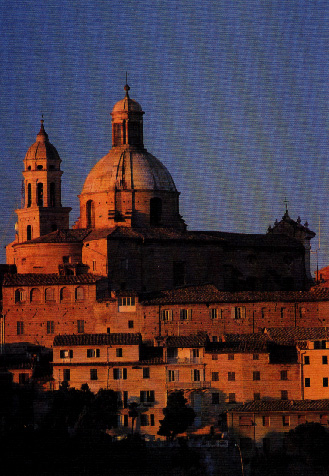
A part of the old town, showing the old infrastructure.
|
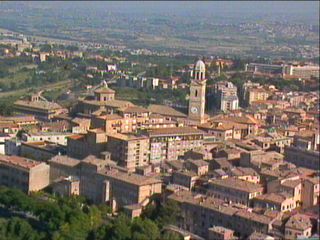
A nice arial shot of the old town.
|
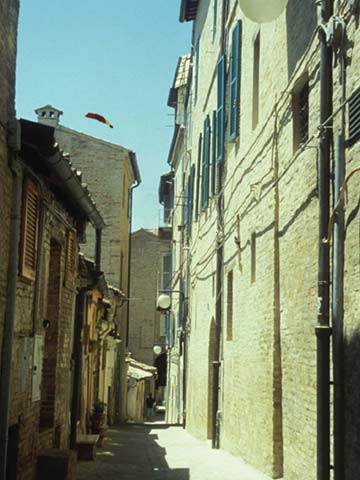
The streets were very narrow and sometimes confusing...
|

Here you can see some of the surrounding countryside.
|
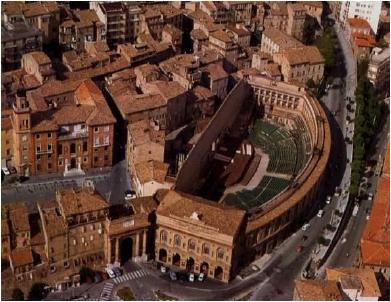
This is an outdoor 19th century ampitheature originally built for handball games. It is called the Sferisterio. Today it has become the stage for the famous Macerata Opera Festival. Our house was in the red roofed building on the top right, next to the white buildings.
|
We woke up that day in Macerata. It was approximately 11ish in the morning before we stirred. Then we remembered we were in Italy and didn't wanna spend the day in bed. So we quickly got up, got dressed, and made plans to head to the beach. We brought our keg with us, met the Italian contacts and made for the sunny Adriatic beach! We played kick ball in the sand and showed off our muscles to the locals. Then me and Nate decided to try swimming. It was frightfully cold, then Nate wimped out so I was forced to return haha! After the beach we got some Italian Pizza, and bought lots of wine for later on. That nite we ate supper at the local Mensa with Dan2. For 3E you get alot of really good food (pastas, breads, a meat and veggie dish, wine, water, ice cream, a fruit). Wish my Mensa was so good! After eating we decided to go check out some local clubs. First we visited a local pub, that was kind of chillin'. Later we went to another club called Number 1, a really hyped, fast pace nightclub. Did I mention Italian girls are HOT!?? Well, wait until you see them dancing! We spent the rest of the nite at this club. It was in this club that we saw Luciano Pavarotti of the 3 Tenors. The guys thought he was a fake but he looked identical. He just sat there drinking a cocktail, and chatting to various people. Well fake or not, it was a good time! We never left before 3:30, then getting some food we were home and asleep by 4:30AM! Well here are the pics from Day 2 of this Italian Road Trip!
Pics from Day 2 of the Italy Road Trip.

Me standing next to our keg!
|

Getting ready to head to the beach.
|

The Piazza of Macerata. The following day was National Italian Independence Day, but rain cancelled the celebrations...
|

About to head to the beach!
|

The back seat!
|

The beach at Macerata.
|

And the other direction! It seems the rain cleared up just for us!
|

Drinking beer on the beach: Dan2, Dan1, Me.
|

The night in Macerata, we were heading to the clubs.
|

Yes cars actually drive in these narrow streets. I did it...
|
Continue on to Day 3 by clicking here.